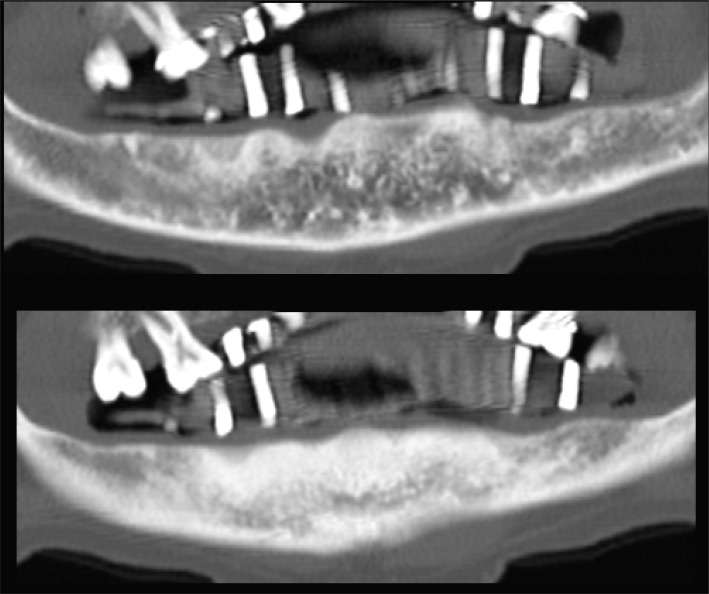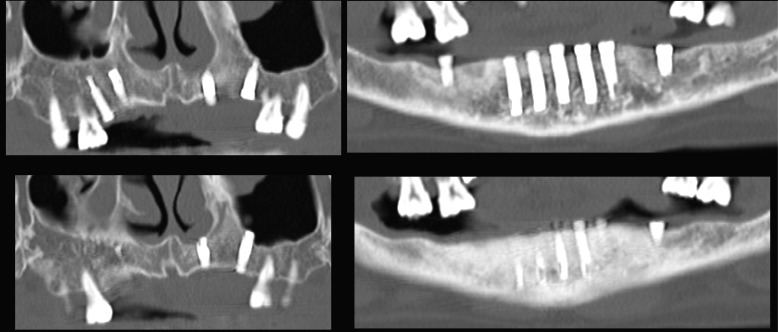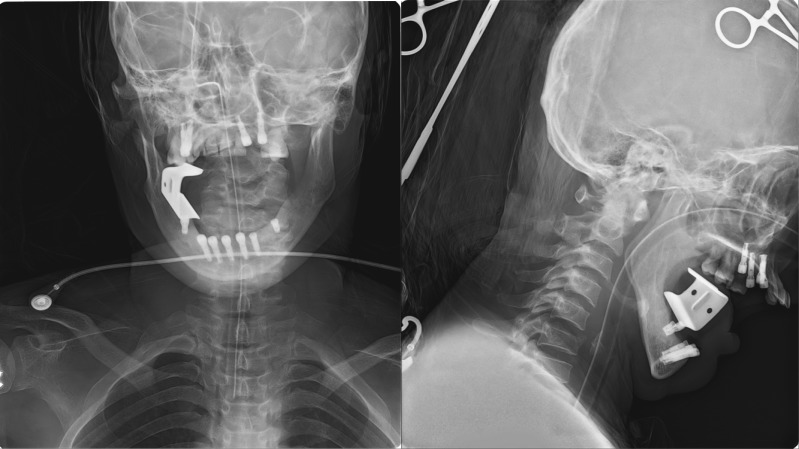J Dent Anesth Pain Med.
2017 Jun;17(2):149-155. 10.17245/jdapm.2017.17.2.149.
Prognosis after treatment with multiple dental implants under general anesthesia and sedation in a cerebral palsy patient with mental retardation: A case report
- Affiliations
-
- 1Department of Oral and Maxillofacial Surgery, Seoul National University, School of Dentistry, Seoul, Korea.
- 2Woojung Dental Clinic, Seoul, Korea.
- 3Department of Dental Anesthesiology, Seoul National University, School of Dentistry, Seoul, Korea. stone90@snu.ac.kr
- KMID: 2384478
- DOI: http://doi.org/10.17245/jdapm.2017.17.2.149
Abstract
- Cerebral palsy is a non-progressive disorder resulting from central nervous system damage caused by multiple factors. Almost all cerebral palsy patients have a movement disorder that makes dental treatment difficult. Oral hygiene management is difficult and the risks for periodontitis, dental caries and loss of multiple teeth are high. Placement of dental implants for multiple missing teeth in cerebral palsy patients needs multiple rounds of general anesthesia, and the prognosis is poor despite the expense. Therefore, making the decision to perform multiple dental implant treatments on cerebral palsy patients is difficult. A 33-year-old female patient with cerebral palsy and mental retardation was scheduled for multiple implant treatments. She underwent computed tomography (CT) under sedation and the operation of nine dental implants under general anesthesia. Implant-supported fixed prosthesis treatment was completed. During follow-up, she had the anterior incisors extracted and underwent the surgery of 3 additional dental implants, completing the prosthetic treatment. Although oral parafunctions existed due to cerebral palsy, no implant failure was observed 9 years after the first implant surgery.
MeSH Terms
Figure
Cited by 1 articles
-
Prognosis following dental implant treatment under general anesthesia in patients with special needs
Il-hyung Kim, Tae Seong Kuk, Sang Yoon Park, Yong-suk Choi, Hyun Jeong Kim, Kwang-Suk Seo
J Dent Anesth Pain Med. 2017;17(3):205-213. doi: 10.17245/jdapm.2017.17.3.205.
Reference
-
1. Bax MC. Terminology and classification of cerebral palsy. Dev Med Child Neurol. 1964; 6:295–297. PMID: 14155190.
Article2. Nelson K, Emery ES 3rd. Birth asphyxia and the neonatal brain: What do we know and when do we know it? Clin Perinatol. 1993; 20:327. PMID: 8358954.
Article3. Nolan J, Chalkiadis G, Low J, Olesch C, Brown T. Anaesthesia and pain management in cerebral palsy. Anaesthesia. 2000; 55:32–41. PMID: 10594431.
Article4. Seo KS, Lee JH, Shin TJ, Yi YE, Kim HJ, Yum K-W, et al. Intravenous sedation of cerebral palsy patient for dental implant ct taking-a case report. J Korean Assoc Disabil Oral Health. 2008; 4:21–25.5. Nelson KB, Grether JK. Potentially asphyxiating conditions and spastic cerebral palsy in infants of normal birth weight. Am J Obstet Gynecol. 1998; 179:507–513. PMID: 9731861.
Article6. Dite GS, Bell R, Reddihough DS, Bessell C, Brennecke S, Sheedy M. Antenatal and perinatal antecedents of moderate and severe spastic cerebral palsy. Aust N Z J Obstet Gynaecol. 1998; 38:377–383. PMID: 9890213.
Article7. Badawi N, Watson L, Petterson B, Blair E, Slee J, Haan E, et al. What constitutes cerebral palsy? Dev Med Child Neurol. 1998; 40:520–527. PMID: 9746004.
Article8. Song JW, Lee KH. A statistical study on the dental caries incidence and plaque index in cerebral palsy person. J Korean Acad Pediatr Dent. 2002; 29:318–327.9. Chung JM, Seo KS, Yi YE, Han HJ, Han JH, Kim HJ, et al. Dental treatment of a patient with cerebral palsy under general anesthesia. J Korean Dent Soc Anesthesiol. 2008; 8:22–28.
Article10. Seo KS, Jang KT, Kim HJ, Yum KW. The status of comprehensive dental treatment and type of disabilities of the patients treated under outpatient general anesthesia at the clinic for the disabled in seoul national university dental hospital. J Korean Dent Soc Anesthesiol. 2006; 6:82–88.
Article11. Loyola-Rodriguez JP, Aguilera-Morelos AA, Santos-Diaz MA, Zavala-Alonso V, Davila-Perez C, Olvera-Delgado H, et al. Oral rehabilitation under dental general anesthesia, conscious sedation, and conventional techniques in patients affected by cerebral palsy. J Clin Pediatr Dent. 2004; 28:279–284. PMID: 15366612.
Article12. Rogers J. Implant-stabilized complete mandibular denture for a patient with cerebral palsy. Dent Update. 1995; 22:23–26. PMID: 7664968.13. López-Jiménez J, Romero-Dominguez A, Gimenez-Prats M. Implants in handicapped patients. Med Oral. 2003; 8:288–293. PMID: 12937390.14. Kubo K, Kimura K. Implant surgery for a patient with parkinson's disease controlled intravenous midazolam: A case report. Int J Oral Maxillofac Implants. 2004; 19:288–290. PMID: 15101602.15. Ekfeldt A. Early experience of implant-supported prostheses in patients with neurologic disabilities. Int J Prosthodont. 2005; 18:132–138. PMID: 15889661.16. Oczakir C, Balmer S, Merickse-Stern R. Implant-prosthodontic treatment for special care patients: A case series study. Int J Prosthodont. 2005; 18:383–389. PMID: 16220802.17. Cune MS, Strooker H, van der Reijden WA, de Putter C, Laine ML, Verhoeven JW. Dental implants in persons with severe epilepsy and multiple disabilities: A long-term retrospective study. Int J Oral Maxillofac Implants. 2009; 24:534–540. PMID: 19587878.
- Full Text Links
- Actions
-
Cited
- CITED
-
- Close
- Share
- Similar articles
-
- Anesthetic Management for a Patient with Total Body Cerebral Palsy: A case report
- Dyspnea after General Anesthesia in a Patient with Cerebral Palsy: A Case Report
- Prognosis following dental implant treatment under general anesthesia in patients with special needs
- Use of Sevoflurane Inhalation Sedation for Disabled Outpatient Dental Treatment
- Use of ADMSâ„¢ during sedation for dental treatment of an intellectually disabled patient: a case report





